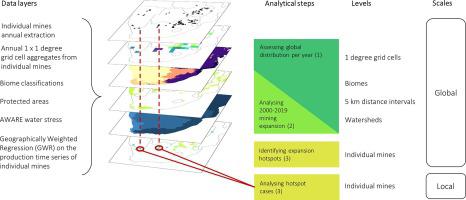Global Environmental Change ( IF 8.9 ) Pub Date : 2021-06-03 , DOI: 10.1016/j.gloenvcha.2021.102303 Sebastian Luckeneder , Stefan Giljum , Anke Schaffartzik , Victor Maus , Michael Tost

|
Mining activities induce profound changes to societies and the environment they inhabit. With global extraction of metal ores doubling over the past two decades, pressures related to mining have dramatically increased. In this paper, we explore where growing global metal extraction has particularly taken effect. Using fine-grain data, we investigate the spatial and temporal distribution of mining of nine metal ores (bauxite, copper, gold, iron, lead, manganese, nickel, silver and zinc) across approximately 3,000 sites of extraction worldwide between 2000 and 2019. To approach the related environmental implications, we intersect mining sites with terrestrial biomes, protected areas, and watersheds categorised by water availability. We find that 79% of global metal ore extraction in 2019 originated from five of the six most species-rich biomes, with mining volumes doubling since 2000 in tropical moist forest ecosystems. We also find that half of global metal ore extraction took place at 20 km or less from protected territories. Further, 90% of all considered extraction sites correspond to below-average relative water availability, with particularly copper and gold mining occurring in areas with significant water scarcity. Our study has far-reaching implications for future global and local policy and resource management responses to mitigate the negative effects of the expected expansion of metal mining.
中文翻译:

全球金属开采激增威胁脆弱的生态系统
采矿活动给社会及其居住的环境带来了深刻的变化。随着全球金属矿石开采量在过去二十年翻了一番,与采矿相关的压力急剧增加。在本文中,我们探讨了不断增长的全球金属提取在哪些方面发挥了特别作用。使用细粒度数据,我们调查了 2000 年至 2019 年间全球约 3,000 个开采地点的九种金属矿石(铝土矿、铜、金、铁、铅、锰、镍、银和锌)的开采时空分布。为了解决相关的环境影响,我们将采矿场与陆地生物群落、保护区和按水资源可用性分类的流域相交。我们发现 2019 年全球金属矿石开采量的 79% 来自六个物种最丰富的生物群落中的五个,自 2000 年以来,热带潮湿森林生态系统的采矿量翻了一番。我们还发现,全球一半的金属矿石开采发生在距保护区 20 公里或更短的地方。此外,所有考虑的开采地点中有 90% 对应于低于平均水平的相对可用水量,特别是铜和金矿开采发生在严重缺水的地区。我们的研究对未来的全球和地方政策和资源管理响应具有深远的影响,以减轻金属采矿预期扩张的负面影响。特别是在严重缺水的地区开采铜和金。我们的研究对未来的全球和地方政策和资源管理响应具有深远的影响,以减轻金属采矿预期扩张的负面影响。特别是在严重缺水的地区开采铜和金。我们的研究对未来的全球和地方政策和资源管理响应具有深远的影响,以减轻金属采矿预期扩张的负面影响。


























 京公网安备 11010802027423号
京公网安备 11010802027423号